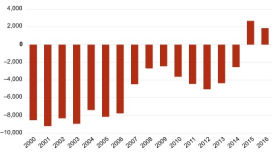Analytics, Demography, Estonia
International Internet Magazine. Baltic States news & analytics
Friday, 19.04.2024, 16:09
The population of Estonia increased last year
 Print version
Print version |
|---|
The population decreased by 1,370 due to negative natural increase (the number of deaths exceeded the number of births) and increased by 3,220 due to positive net migration (more persons immigrated to Estonia than emigrated). In total, the population of Estonia increased by 0.14% in 2016. The population of Estonia has increased for two years already, because immigration has been higher than emigration and negative natural increase.
More than 13,900 children were born in Estonia in 2016. The number of births has remained at approximately the same level for five years. Considering that the number of women in childbearing age has decreased, it could be seen as good news, but there is still a long way to go before really good news in births statistics.
There were 15,300 deaths in 2016. The number of deaths has remained at this level for six years in a row, varying by just +/-150. As the population is ageing and the number of older people increases year after year, it is expected that life expectancy will continue to increase.
The current outcome is based on changes of residence in the population register in 2016 – persons whose residence was not Estonia at the previous year-end but was so at this year-end are considered immigrants, and the persons whose residence was Estonia at the previous year-end but not at this year-end are considered emigrants.








 «The Baltic Course» Is Sold and Stays in Business!
«The Baltic Course» Is Sold and Stays in Business!

